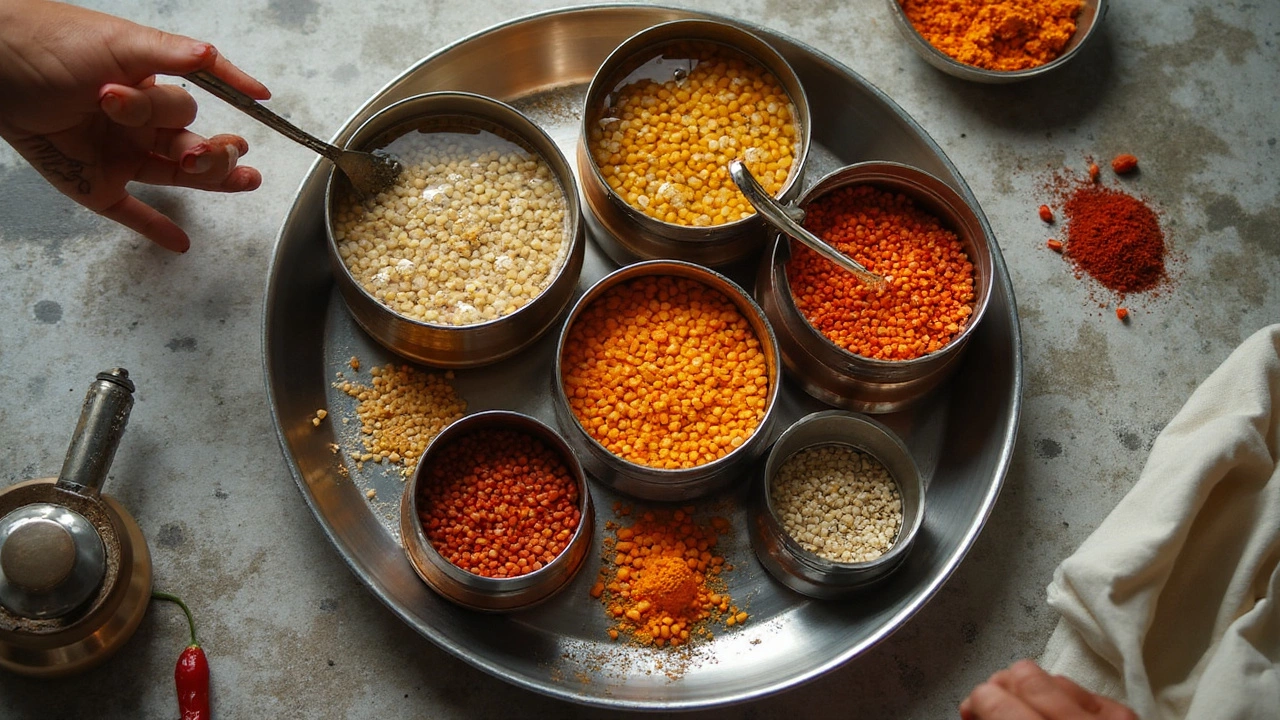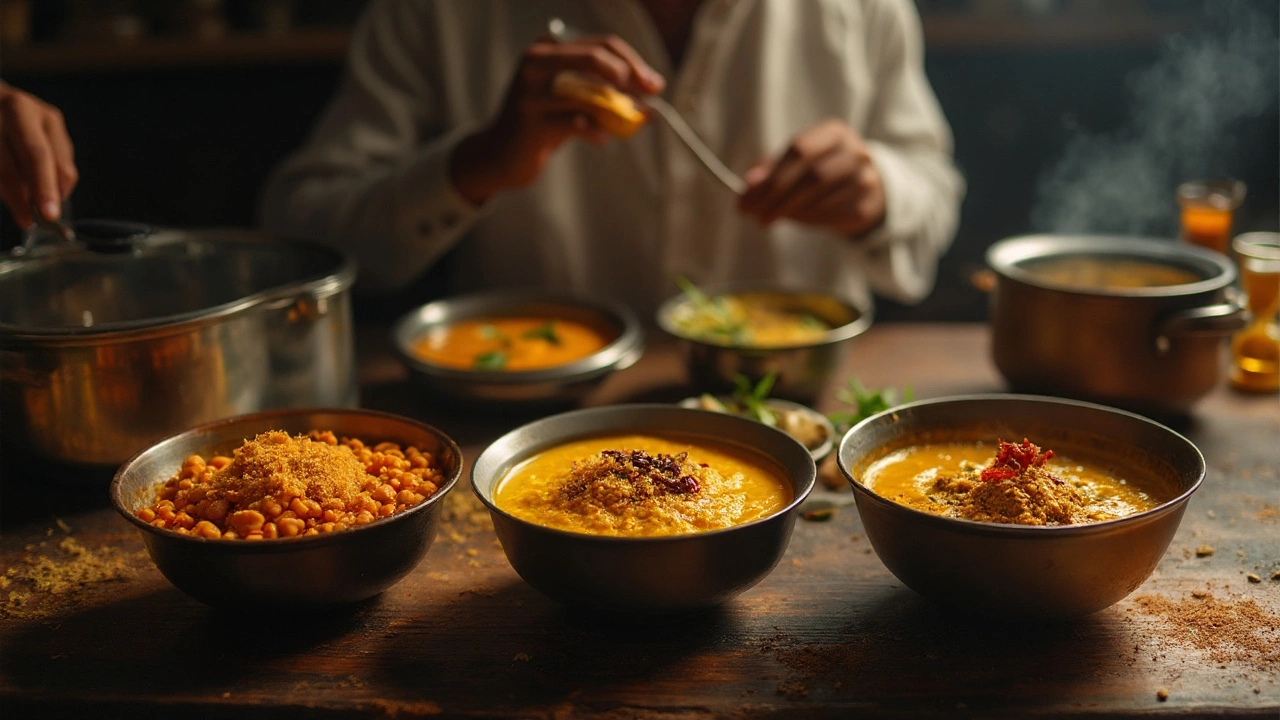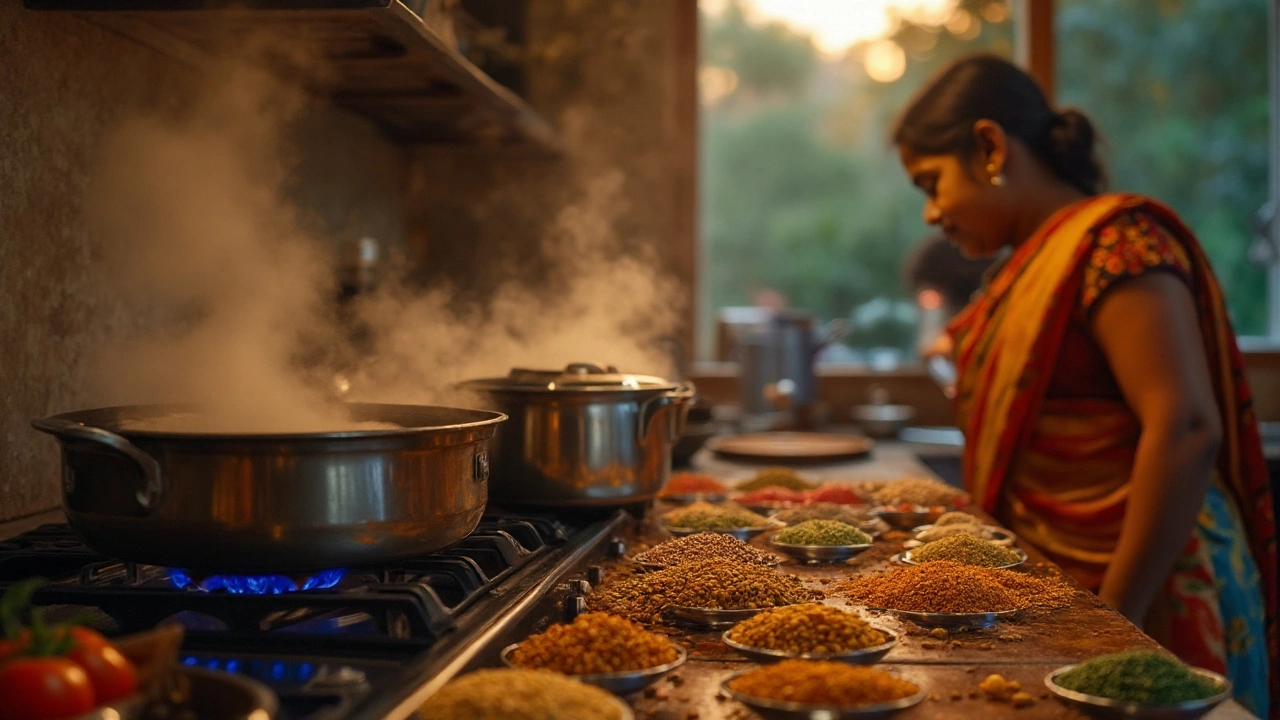You want dinner on time, not guesswork. Dal can be ready in 12 minutes or two hours depending on the pulse and method. Here’s a reliable answer you can use tonight, with time ranges that match real kitchens, not wishful thinking.
Dal is a family of Indian dishes made from split pulses (lentils, chickpeas, pigeon peas, and others) simmered until tender, then finished with a fat-sizzled seasoning called tempering.
Quick answer
- Red lentils (masoor, split): 12-15 min stovetop simmer; 1 whistle (2-3 min) in a stovetop pressure cooker; 3-5 min on Instant Pot High Pressure.
- Toor dal (pigeon pea, split): 35-45 min stovetop; 3-4 whistles (8-10 min) pressure cooker; 6-8 min Instant Pot + 10 min natural release.
- Chana dal (split chickpea): 45-60 min stovetop; 6-8 whistles (15-20 min) pressure cooker; 12-15 min Instant Pot + 10 min natural release.
- Moong dal (split mung): 20-25 min stovetop; 2-3 whistles (5-7 min) pressure cooker; 5-6 min Instant Pot.
- Urad dal, split: 25-30 min stovetop; 3-4 whistles (7-9 min) pressure cooker; 7-8 min Instant Pot.
- Urad dal, whole (for dal makhani): Soak 6-8 hours. 90-120 min stovetop; 25-30 min pressure cooker; 30-35 min Instant Pot + natural release.
Here’s your cheat sheet for dal cooking time across the most common types. Below you’ll also find exact water ratios, whether to soak, and how salt, acid, and altitude change the clock.
Know your dal: types and what that means for time
Split pulses cook faster because the seed coat is removed and water penetrates quickly. Whole pulses need soaking and patience. Age matters too: older stock cooks slower. Hard water stretches time; a pinch of baking soda shortens it (use sparingly to avoid mushy textures).
Masoor dal (red lentils) are Lens culinaris, usually sold split and skinned; they turn golden and soft fast, ideal for 20-minute dinners.
Toor dal (pigeon pea) is Cajanus cajan, split and skinned; slightly starchy, classic for sambar, takes moderate time and benefits from a brief soak.
Chana dal is split Cicer arietinum (desi chickpea); dense and hearty, needs longer cooking or a decent soak.
Moong dal is split Vigna radiata (mung bean); gentle, creamy, and quick-cooking, great for light dals and khichdi.
Urad dal is Vigna mungo (black gram); split cooks in moderate time; whole needs soaking and long cooking for dal makhani.
Exact water ratios and times by method
These ratios give you a pourable, spoonable dal. For thicker dal, reduce water by 1/4 cup per cup of dal. For thinner, add 1/2 cup hot water at the end and simmer 2-3 minutes.
Stovetop simmer (covered pot)
- Rinse 1 cup dal until water runs mostly clear.
- Add 3-4 cups water (see dal-specific ratios below), 1/4 tsp turmeric, and 1/2 tsp oil to reduce foaming.
- Bring to a boil, skim foam, then simmer covered until tender. Stir every 8-10 minutes.
- Finish with salt, tempering, and acid (tomato/lemon) after the dal is soft.
Stovetop pressure cooker (Indian “whistle” type)
- Same rinse and water ratio as stovetop. Lock the lid.
- Cook on medium heat until you hear the first whistle; reduce heat to low-medium and count whistles/time below.
- Let pressure drop naturally for 5-10 minutes before opening.
Instant Pot is an electric pressure cooker that controls pressure and time electronically with High/Low settings and automatic keep-warm. (electric pressure cooker)
- Rinse dal. Use the given water ratio. Select Pressure Cook (High).
- Set the timer from the chart below. Natural release for 10 minutes for anything firmer than red lentils.
- Open, mash to desired texture, and temper.
| Dal type | Split/Whole | Soak? | Water ratio (cup water per 1 cup dal) | Stovetop simmer | Stovetop pressure cooker | Instant Pot (High) | Notes |
|---|---|---|---|---|---|---|---|
| Masoor (red lentils) | Split | No | 3 to 3.5 | 12-15 min | 1 whistle (2-3 min) | 3-5 min; quick release | Very soft quickly; easy to overcook beyond 7 min. |
| Toor (pigeon pea) | Split | Optional 30 min | 3 to 3.5 | 35-45 min | 3-4 whistles (8-10 min) | 6-8 min; 10 min natural release | For sambar, keep a little texture; for plain dal, cook fully. |
| Chana dal (split chickpea) | Split | Recommended 1-3 h | 3.5 to 4 | 45-60 min | 6-8 whistles (15-20 min) | 12-15 min; 10 min natural release | Without soaking, add 5-8 min more under pressure. |
| Moong dal (yellow) | Split | No | 3 | 20-25 min | 2-3 whistles (5-7 min) | 5-6 min; quick release | Great for light, creamy consistency; mashes easily. |
| Urad dal (split) | Split | No | 3 to 3.5 | 25-30 min | 3-4 whistles (7-9 min) | 7-8 min; 10 min natural release | Good for North Indian tarka-style dals. |
| Urad (black gram) whole | Whole | Yes 6-8 h | 5 | 90-120 min | 25-30 min | 30-35 min; full natural release | Classic for dal makhani; slow simmer deepens flavor. |
| Masoor (brown) whole | Whole | Optional 1 h | 3 | 25-35 min | 4-5 whistles (10-12 min) | 8-10 min; quick release | Holds shape if not overcooked; good in salads too. |
What changes the clock (and what to do about it)
- Split vs whole: Split cooks 2-4× faster than whole. Whole seeds have intact skins that slow hydration.
- Soaking: 30 minutes trims 5-10 minutes off toor; 1-3 hours trims 10-20 minutes off chana; 6-8 hours is essential for whole urad.
- Salt and acid: Add salt after dal is soft if you’re simmering on the stovetop. Salt and acids (tomato, tamarind, lemon) can slow softening by stabilizing cell walls. Pressure cooking reduces this effect, so you can salt earlier if you prefer.
- Water hardness: Hard water (high calcium/magnesium) toughens skins. Use filtered water or add a pinch (1/8 tsp per cup dal) baking soda. Don’t overdo it-too much turns dal soapy and mushy.
- Age of dal: Old stock takes longer. If your bag has been in the pantry for a year, add 10-20% time.
- Altitude: Above 600 m, water boils at lower temperatures. Add 5% time for every additional 300 m. At sea level, times in the table hold steady.
- Pot shape and size: Wider pots evaporate faster, thickening dal and slowing softening. Keep lids on and stir every 10 minutes to prevent sticking.
Tempering: flavor at the finish
Cook time ends when the dal is soft. Flavor peaks when you pour in hot, spiced fat.
Tempering (tadka) is the technique of heating ghee or oil with spices (like cumin, mustard seed, dried chillies, garlic) and pouring it over cooked dal to infuse aroma and flavor.
- Classic North Indian: ghee, cumin seeds, garlic, dried red chilli, hing (asafoetida).
- South Indian for sambar/toor: oil, mustard seeds, curry leaves, fenugreek, asafoetida.
- Add tomato or lemon after the dal is tender to keep cooking times predictable.
Step-by-step times you can trust
Masoor dal (split red)
For two generous bowls: 1 cup masoor, 3 to 3.5 cups water, 1/4 tsp turmeric.
- Stovetop: simmer 12-15 min, then mash lightly. Salt to taste. Temper.
- Pressure cooker: 1 whistle (2-3 min). Natural release 5 min. Temper.
- Instant Pot: 4 min High; quick release. Temper.
Toor dal (split pigeon pea)
For sambar-like texture: 1 cup toor, 3.25 cups water.
- Soak optional 30 min to shave time and improve creaminess.
- Stovetop: 35-45 min to fully soft. Mash.
- Pressure cooker: 3-4 whistles (8-10 min). Natural release 10 min.
- Instant Pot: 7 min High + 10 min natural release.
Chana dal (split chickpea)
For a tender-but-shapely texture: 1 cup chana dal, 3.75 to 4 cups water.
- Soak 1-3 hours if you want reliable tenderness under pressure.
- Stovetop: 45-60 min. Without soak, closer to 60.
- Pressure cooker: 6-8 whistles (15-20 min). Add 3-5 min if not soaked.
- Instant Pot: 13 min High + 10 min natural release (soaked) or 17 min (not soaked).
Moong dal (split yellow)
For a light, silky bowl: 1 cup moong dal, 3 cups water.
- Stovetop: 20-25 min, stir mid-way to prevent sticking.
- Pressure cooker: 2-3 whistles (5-7 min). Quick natural release.
- Instant Pot: 5-6 min High; quick release for a bit of texture, or 7 min for very soft.
Urad dal (split) and whole urad
Split: 1 cup, 3-3.5 cups water. Whole urad for dal makhani: 1 cup soaked 6-8 hours, 5 cups water.
- Split stovetop: 25-30 min. Split Instant Pot: 7-8 min + 10 min natural release.
- Whole stovetop: 90-120 min gentle simmer until creamy; keep adding hot water.
- Whole pressure cooker: 25-30 min (stovetop) or 30-35 min (Instant Pot) + full natural release. Simmer with butter/cream later for gloss.
Method choices: which one should you use?
- Stovetop simmer is best for control and small batches; you can stop right at “just tender.”
- Pressure cooker is a sealed stovetop vessel that raises boiling temperature via steam pressure to cook legumes faster. This is your friend for toor and chana dal on a tight schedule.
- Instant Pot shines for hands-off cooking and consistent results, especially with whole urad. It prevents boil-overs and frees you to prep tempering.

Real-life timing scenarios
- Weeknight sprint: Choose split masoor or moong. You’ll be eating in 20 minutes, including tempering.
- Meal prep for 3 days: Make 2 cups toor in an Instant Pot (7 min High + 10 min natural release). It reheats well and doesn’t get pasty like masoor can.
- Company dinner: Whole urad in Instant Pot 35 min + natural release, then simmer with tomatoes, butter, and cream for 20 minutes more. Deep flavor without babysitting.
- Budget lunchbox: Chana dal 15 min High (soaked) holds its shape, pairs well with rice and a squeeze of lemon.
Water ratio rules of thumb
- Split dals: 1 cup dal to 3-3.5 cups water.
- Whole lentils/beans: 1 cup dal to 4-5 cups water (more for very long simmers).
- Thick tadka-style: start at 1:3, adjust after tempering.
- Sambar consistency: lean to 1:3.5 so it flows well with rice or idli.
Flavor add-ins without delaying tenderness
- Add turmeric at the start; it doesn’t toughen skins.
- Add tomatoes, tamarind, or lemon juice after the dal is soft (or at the end of pressure cooking).
- Salt late on the stovetop; add earlier under pressure if you like, since pressure offsets the slowdown.
- Use ghee for a richer mouthfeel; mustard oil or neutral oil works for vegan versions.
Connected topics you might be curious about next
- Rice timings: basmati cooks in 10-12 minutes on the stovetop or 4-6 minutes High Pressure (1:1 water in Instant Pot for soaked rice).
- Khichdi: moong dal + rice (1:1 dal:rice) with 4 cups water for porridge-like comfort, 6-8 minutes on Instant Pot High.
- Sambar specifics: toor dal base with tamarind and veggies; cook dal fully first, then simmer with sambar powder 8-10 minutes.
- Dal makhani technique: pressure-cooked whole urad and kidney beans, then low simmer 30-45 minutes with butter/cream for gloss and depth.
Troubleshooting and pro tips
- Dal still firm after time? Add 1/4 cup hot water and simmer 5-10 minutes more. If very firm, your water may be hard-add a tiny pinch of baking soda and cook 5 minutes.
- Dal too thick? Stir in hot water in 1/4-cup increments; re-season with salt and a squeeze of lemon.
- Dal too thin? Simmer uncovered for 5-10 minutes, or mash a ladleful against the pot sides to thicken.
- Foam overflow in pressure cooker? Add 1/2 tsp oil to the pot and avoid overfilling past 1/2 mark with legumes.
- Uneven cooking? Stir midway and scrape the bottom. Hot spots can dry out the base and slow softening.
- Flavor falling flat? Temper properly: heat fat till shimmering, bloom whole spices 30-45 seconds, add aromatics briefly, then pour over the dal.
Why these times work (the quick science)
Legume tenderness comes from starch gelatinization and pectin breakdown in the cell walls. Pressure raises the boiling point so these changes happen faster, which is why chana and toor soften more reliably under pressure. Acids stabilize pectin, slowing softening; salt also strengthens cell-wall interactions but the effect is muted under pressure. Food science references like Harold McGee’s On Food and Cooking, and standard legume tables from the USDA and pressure cooker manuals, support these patterns.
Definitions of primary entities used in this guide
Red lentils (masoor, split) A fast-cooking split pulse (Lens culinaris) that turns golden and creamy; great for quick weekday dals.
Toor dal (pigeon pea, split) A starchy, split pulse (Cajanus cajan) used in sambar and Gujarati dals; medium cook time.
Chana dal (split chickpea) A dense, nutty split pulse (Cicer arietinum) that holds shape if undercooked; benefits from soaking.
Moong dal (split mung) A gentle split pulse (Vigna radiata) that cooks quickly and digests easily; perfect for khichdi.
Urad dal (black gram) A protein-rich pulse (Vigna mungo) used split for quick dals and whole for dal makhani; whole requires soaking.
Pressure cooker (stovetop) A sealed pot that cooks at higher-than-boiling temperatures via steam pressure; Indian models signal with whistles.
Instant Pot (electric pressure cooker) A countertop appliance that automates pressure cooking with electronic controls for time, pressure, and release.

Frequently Asked Questions
Do I need to soak dal?
Split dals like masoor and moong do not need soaking and cook quickly. Toor benefits from a 30-minute soak for creamier results. Chana dal softens more reliably with a 1-3 hour soak. Whole urad absolutely needs 6-8 hours. Soaking shortens cook time and improves texture, especially for whole or dense pulses.
When should I add salt and tomatoes to dal?
On the stovetop, wait until the dal is tender, then add salt and acidic ingredients like tomatoes, tamarind, or lemon. Under pressure, you can salt earlier because pressure reduces the toughening effect. If your dal often stays firm, add acids at the end no matter the method.
Why is my dal taking so long to cook?
Common culprits are hard water, very old pulses, added acid early in the cook, or simmering without a lid. Try filtered water, a small pinch of baking soda (1/8 tsp per cup dal), add acids at the end, and keep the pot covered. If you live at altitude, increase time by ~5% for every 300 m above 600 m.
How do I know when dal is done?
Press a grain against the pot with a spoon or your fingers. Done means it smears without a hard core. For chana dal, you may want a slight bite; for masoor or moong, fully soft and mashable is typical. If making dal makhani, aim for creamy whole urad with some intact skins but no chalky center.
What’s the best water ratio for dal?
For most split dals, use 3-3.5 cups water per cup of dal. For whole pulses, 4-5 cups per cup of dal. Adjust by 1/4 cup to fine-tune thickness. Add hot water near the end if needed; avoid big cold water additions that drop the simmer.
Instant Pot or stovetop: which gives better texture?
Instant Pot offers consistency and hands-off cooking, especially for toor, chana, and whole urad. Stovetop gives more control if you like a very specific doneness or prefer to mash gradually. For very quick dals like masoor, both methods work; the stovetop can be faster because there’s no pressure build time.
Can I cook dal with rice together?
Yes-khichdi is exactly that. Use moong dal and short-to-medium grain rice in a 1:1 ratio with about 4 cups water for porridge-like texture, 6-8 minutes High Pressure with a 10-minute natural release. Avoid toor or chana with rice in one pot unless you plan for longer times, which may overcook the rice.
How do I stop dal from boiling over?
Use a larger pot, add 1/2 teaspoon oil to reduce foaming, keep the lid slightly ajar until the initial boil settles, and skim foam. In pressure cookers, never fill more than half full with legumes and liquid.
Can I batch-cook dal and freeze it?
Absolutely. Cook plain dal (without tempering) to tender, cool, and freeze in portions for up to 3 months. Reheat gently with a splash of water and add fresh tempering for vibrant flavor. Masoor can thicken a lot after freezing-thinning with hot water brings it back.
What’s the healthiest dal for quick meals?
Moong and masoor are fast and easy to digest, with good protein and fiber. If you want sustained fullness, toor offers a bit more starch and body. For iron and protein density, whole urad is great, but it takes longer and is richer.
